Ahmaogak
Crew's Whale
Excerpts from The
Whale and the Supercomputer. I took these photographs at the
same time as the events described (the photos do not appear in the
book).
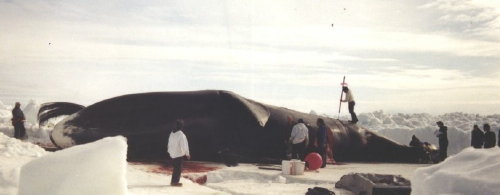
|
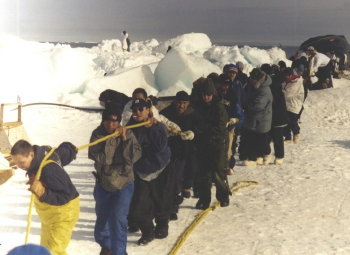
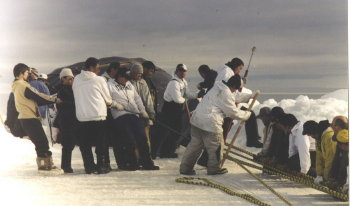
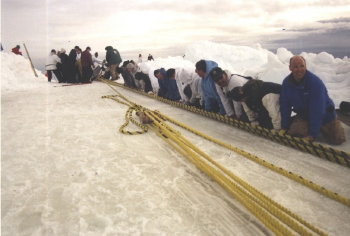
|
At the cry of, “All hands!” we stood
together holding the
yellow rope, a great, joyous crowd in the early morning, strung out
several
hundred feet along the ice trail leading away from the whale’s tail,
and
someone cried out, “Walk away!” We walked, stretching the line, pulling
harder
as it grew taut, reaching the end of the trail and jogging back to the
starting
point to grab hold and keep pulling. We pulled hard, we got stuck, we
were
encouraged by loud calls of “Walk away, walk away,” we moved again.
Some
strained to pull, some paced themselves. Some strong young guys were
caught
smoking behind their tents and put back to work. The whale made little
perceptible movement. We’d stretched that long rope out, however,
pulling the
two blocks of the secondary, helper block and tackle together so we
could go no
farther. Now it was time to reattach the helper block and tackle to the
heavier
block and tackle set--to bring the helper line in so we could pull it
out once
again.
A dozen men threw themselves to their
knees along the larger
block and tackle and, weaving their fingers among ropes as taut as
steel bars,
twisted the lines together to keep the whale from slipping back while
the
helper rope was released and retied. The line slipped a little, the men
twisted
harder, a member of the Ahmaogak crew jammed a long-handled tool into
the block
to stop it. The helper line was retied. A whale this size weighs well
over 100,000
pounds, more than a fully loaded tractor trailer. In 1992 a ring
holding the
helper block separated--that was the same old whale in which Craig
George found the stone spear point--and the 35-pound
block
shot through the air like a canon ball, faster than the eye could see,
hitting
two women pulling the helper line. One was killed instantly, the other
died
soon after. A sad whale, as people still say. But the work goes on. The
process
of resetting the helper line must be repeated many times to pull in one
whale.
Two hundred workers picked up the line and the cry went up—“Walk away”—
and
again the line stretched and creaked with growing tension.
|
|
No one can own a whale. The whale
gives itself to the entire
community. The whaling captain bears the considerable expense of
year-round
preparation for the hunt and carries the weight of command. The crew
provides
skill and muscle and endures cold, danger, and tedium. Other crews come
to help
kill a struck whale and tow it back to camp. All the crews, and the
entire
community, converge on the ice to pull the whale out of the water and
butcher
it. Everyone who helps receives a share of the whale, as do elders and
the
infirm in town, and relatives far away, who receive care packages
through the
mail. The choicest cuts go to the captain and the crews who made the
largest
contribution. The captain’s family then sets to work to prepare their
share as
a feast for the community, serving a banquet for all comers at their
house as
soon as possible. In addition, for every whale caught in the spring,
the
successful captain’s family serves the community at Nalukataq,
an outdoor festival held in June with the Eskimo
blanket
toss. Falltime whales are served at other special meals--each family
has its
favorite whale recipes for Thanksgiving and Christmas. In the end, the
captain’s compensation is intangible. He receives food for his family
like
everyone else, and the satisfaction that he has fed his people, and the
honor
and respect of the community--a fundamental kind of respect whose value
does
not fluctuate in the market of everyday relationships. These are not
rules of
whaling that can be broken or altered, such as those governing when a
crew can use
the aluminum, or what day the hunt begins.
You can’t be Iñupiaq and own a whale.
Top right, Charles
Wohlforth and Richard Glenn, lower right, Brenton Rexford makes the
first cut.
|
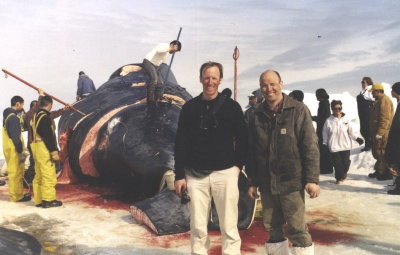
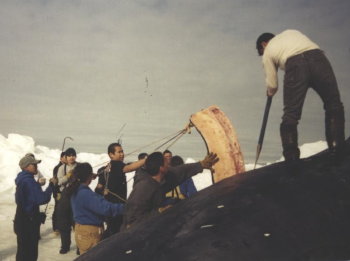
|
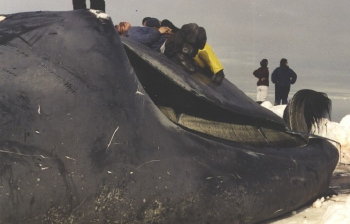
Tired boys absorb the
whale's warmth.
|
|

